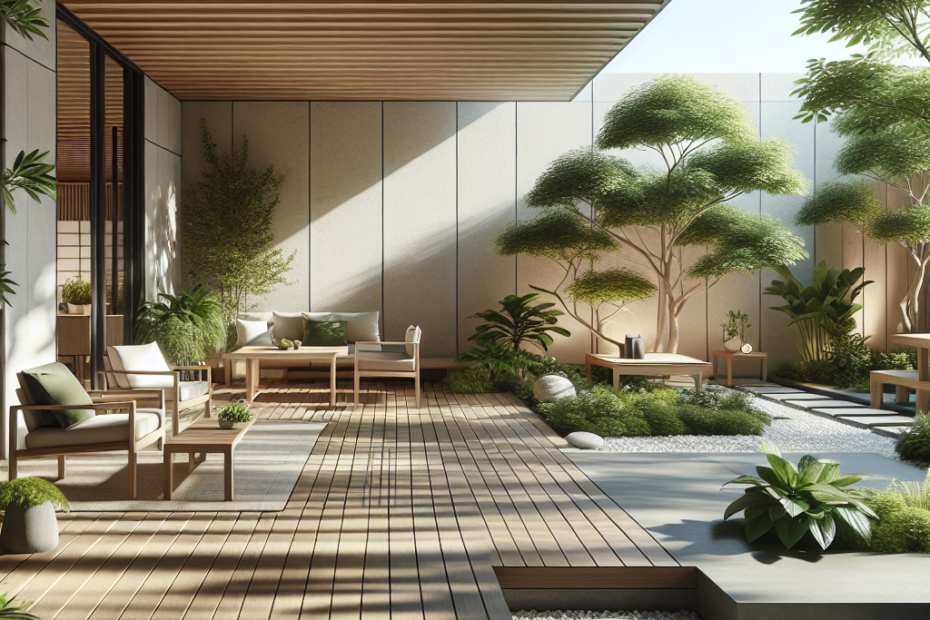“`html
The Essentials of Japandi Outdoor Living Spaces
Japandi Outdoor Design is the perfect blend of Japanese minimalism and Scandinavian functionality. This unique style creates serene and practical outdoor living spaces that are both beautiful and user-friendly. As more people look to create calming backyard retreats, the Japandi design has gained popularity due to its clean lines, natural materials, and emphasis on tranquility. Incorporating this design style into outdoor spaces allows them to enjoy a seamless connection with nature.
A Brief Overview of Japandi Outdoor Design
The term “Japandi” is a fusion of “Japanese” and “Scandinavian.” These two design philosophies are renowned for their simplicity, functionality, and elegance. They share a common ethos of creating harmony between the indoors and outdoors through the careful use of materials, colors, and textures. While Japanese design is inspired by Zen principles focusing on balance and natural elements, Scandinavian design emphasizes coziness and comfort, commonly referred to as “hygge.”
In Japandi Outdoor Design, they aim to achieve a delicate balance between warmth and minimalism. They utilize neutral colors such as beige, gray, and white, along with natural materials like wood, stone, and bamboo, to create cohesive outdoor spaces. The result is areas that are both aesthetically pleasing and functionally efficient.
Key Elements of Japandi Outdoor Living Spaces
1. Neutral Color Palette
Japandi outdoor designs use a muted color palette as a foundation for peace and serenity. Earthy tones such as taupe, soft greens, and gentle blues are prevalent, providing a harmonious backdrop for outdoor activities. This palette is selected to reflect the natural environment and to create a unified look between the indoor and outdoor spaces.
2. Natural Materials
Wood, stone, and bamboo are staples in Japandi outdoor design. These materials ground the space in nature and are often left in their most raw form to maintain authenticity. Bird feeders, planters, and seating often incorporate these elements, creating a seamless blend with the environment.
3. Simple Lines and Clean Shapes
The design philosophy emphasizes uncluttered spaces with straightforward lines and geometric shapes. Outdoor furniture such as benches, tables, and lounges are designed with an emphasis on practicality and functionality. This approach not only enhances the aesthetic appeal but also ensures ease of movement.
4. Focus on Sustainability
With growing environmental awareness, Japandi outdoor spaces often emphasize sustainable choices. They carefully select furniture made from responsibly sourced materials and choose low-maintenance plants that require minimal water. Utilizing solar lights and recycling rainwater for garden use are also common practices in these designs.
5. Integration with Nature
Japandi design encourages a harmonious connection with nature through the incorporation of plants, water features, and natural lighting. Whether it’s a small bamboo plant or a tranquil koi pond, these elements are incorporated to enhance the zen quality of the outdoor space.
Benefits of Japandi Outdoor Living Spaces
According to a study by Houzz in 2022, more than 70% of homeowners who revamped their outdoor spaces reported increased relaxation and satisfaction with their homes (Houzz Magazine). Japandi outdoor design can significantly contribute to improving mental well-being by providing a calm retreat away from daily stresses.
| Element | Feature |
|---|---|
| Color Palette | Neutral, Earthy tones |
| Materials | Wood, Stone, Bamboo |
| Shapes | Simple, Geometric |
| Sustainability | Eco-friendly Practices |
| Nature Elements | Plants, Water features |
Creating Your Own Japandi Outdoor Space
To embark on the journey towards a Japandi-styled outdoor space, they must start by embracing the concept of “less is more.” Begin with decluttering and removing unnecessary elements. Selecting a simple yet elegant furniture piece, prioritizing quality over quantity, is essential.
Adding layers with textiles and soft furnishings may enhance the coziness of the space. They should not skimp on quality; instead, choose natural fibers and materials for outdoor rugs, cushions, and blankets.
Final touches often involve thoughtful landscaping choices. Opt for native plants that are easy to maintain and provide year-round interest. Water features, such as a small fountain, can add both a visual and auditory element to the space, contributing to a complete Japandi experience.
Key Takeaways
- Japandi Outdoor Design blends Japanese minimalism with Scandinavian functionality.
- Neutral colors, natural materials, and sustainable choices are key features.
- Simple lines and integration with nature complement the serene environment.
- Benefits include increased relaxation and enhanced mental well-being.
- Creating a Japandi outdoor space involves decluttering and incorporating sustainable practices.
FAQ
1. What is Japandi design?
Japandi design is a fusion of Japanese and Scandinavian styles focusing on simplicity, functionality, and a connection with nature.
2. What materials are commonly used in Japandi Outdoor Design?
Common materials include wood, stone, and bamboo, chosen for their natural and sustainable properties.
3. How does Japandi design promote sustainability?
Japandi design promotes sustainability through the use of eco-friendly materials, low-maintenance plants, and green practices like recycling rainwater.
4. Can Japandi design be expensive to implement?
Implementing Japandi design can vary in cost, but focusing on quality over quantity and making sustainable choices can optimize expenses.
5. What is the main benefit of adopting Japandi outdoor spaces?
The main benefit is the creation of a serene and relaxing outdoor retreat, contributing to improved mental well-being.
“`
